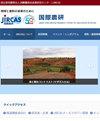Limited Occurrence of Tristeza in Yuzu and Possible Tristeza-free Cultivation in Northernmost Commercial Yuzu-producing Areas of Japan
IF 0.5
4区 农林科学
Q4 AGRICULTURE, MULTIDISCIPLINARY
引用次数: 1
Abstract
Citrus tristeza virus (CTV) commonly infects yuzu (Citrus junos) in most parts of the citrus-growing areas in Japan. This study examined the occurrence of CTV in the northernmost commercial citrusproducing areas of Japan. Colonies of the brown citrus aphid (Toxoptera citricidus) were detected within the areas investigated. However, 23 of the 41 trees that were examined by RT-PCR and both or either subject to stem-pitting observation and immunostrip testing were free of CTV. Several CTVfree trees were apparently more than 60 years old. A field trial revealed that all eight uninoculated seedlings tested negative for CTV at 52 months after transplanting. These results suggest that CTVfree yuzu production is possible in the Rikuzen-Takata and Ofunato areas of Japan. Discipline: Agricultural Environment Additional key words: Citrus junos Sieb. ex Tanaka, Great East Japan Earthquake, Toxoptera citricidus Introduction Yuzu (Citrus junos Sieb. ex Tanaka) is a cold-hardy sour citrus species that can grow in northern areas (Kawase et al. 1983). The yuzu fruit is very popular due to its characteristic flavor and is widely used as a dressing in Japanese cuisine (Miyazawa et al. 2009). The northernmost commercial yuzu-producing areas in Japan overlap with the main apple-growing regions. Specifically, yuzu has been grown for many years in the Rikuzen-Takata and Ofunato areas in Iwate Prefecture (around 39°N and 142°E) (Fig. 1), primarily for ornamental purposes and production of the fruit, which is mainly consumed by the families of local farmers. However, in response to the recent increase in the popularity of yuzu, farmers in the Rikuzen-Takata and Ofunato areas have considered increasing the commercial production of yuzu, with potential financial benefits for these yuzu-producing areas. Yuzu is highly susceptible to citrus tristeza virus (CTV), which commonly infects citrus species (Moreno et al. 2008, Dawson et al. 2015, Harper & Cowell 2016). Yuzu trees infected by CTV grow poorly and often produce relatively small fruits with blemished skin (Ieki 2003). Many yuzu trees in the southern yuzu-producing areas of Japan are affected by tristeza. In Japan, CTV is mainly transmitted by the brown citrus aphid (Toxoptera citricidus) commonly found in the southern yuzuproducing areas (Ieki 2003). The conditions in those areas make it difficult to control the citrus tristeza *Corresponding author: ti207181@nodai.ac.jp Received 19 November 2019; accepted 27 February 2020. 307 JARQ 54 (4), 307-316 (2020) https://www.jircas.go.jp柚子中赤霉病的有限发生及日本最北部商业柚子产区可能的无赤霉病栽培
柑桔tristeza病毒(CTV)通常感染柚子(Citrus junos)在日本大部分柑橘种植区。本研究调查了日本最北部商业柑橘产区CTV的发生情况。在调查区域内发现柑桔褐蚜(Toxoptera citricidus)。然而,通过RT-PCR检测的41棵树中有23棵没有CTV,同时进行了茎蚀观察和免疫条检测。几棵没有ctv的树显然超过了60岁。田间试验表明,在移栽后52个月,8株未接种的幼苗CTV检测均为阴性。这些结果表明,在日本陆前-高田和大船渡地区生产不含ctv的柚子是可能的。学科:农业环境附加关键词:柑桔。原田中,东日本大地震,柑桔弓形虫引种(原Tanaka)是一种耐寒酸柑橘,可以生长在北方地区(Kawase et al. 1983)。柚子因其独特的风味而非常受欢迎,在日本料理中被广泛用作调味品(Miyazawa et al. 2009)。日本最北部的商业鱼祖产区与主要的苹果种植区重叠。具体来说,柚子在岩手县的高田和船渡地区(约北纬39°和东经142°)种植了多年(图1),主要用于观赏和生产果实,主要供当地农民家庭消费。然而,由于最近柚子越来越受欢迎,陆前高田和船渡地区的农民已经考虑增加柚子的商业生产,这对这些柚子产区有潜在的经济效益。柚子对柑橘tristeza病毒(CTV)非常敏感,该病毒通常感染柑橘物种(Moreno et al. 2008, Dawson et al. 2015, Harper & Cowell 2016)。受CTV感染的柚子树生长不良,果实往往较小,果皮有瑕疵(Ieki 2003)。在日本南部的柚子产区,许多柚子树都受到了霉病的影响。在日本,CTV主要由常见于南部柚子产区的褐柑橘蚜(Toxoptera citricidus)传播(Ieki 2003)。这些地区的条件使柑橘tristeza难以控制*通讯作者:ti207181@nodai.ac.jp收到2019年11月19日;2020年2月27日接受。[j] .中国生物工程学报,2016,33 (4):387 - 391 (2020)https://www.jircas.go.jp
本文章由计算机程序翻译,如有差异,请以英文原文为准。
求助全文
约1分钟内获得全文
求助全文
来源期刊
CiteScore
1.00
自引率
25.00%
发文量
42
审稿时长
>36 weeks
期刊介绍:
The Japan Agricultural Research Quarterly (JARQ) is a publication of the Japan International Research Center for Agricultural Sciences (JIRCAS), which provides readers overseas with the latest information on key achievements and developments in agricultural research in Japan, with the expectation that this information would contribute to the agricultural development of countries in tropical and subtropical regions.

 求助内容:
求助内容: 应助结果提醒方式:
应助结果提醒方式:


